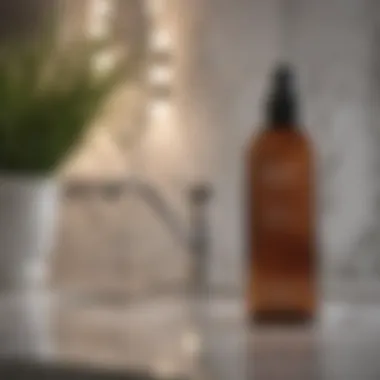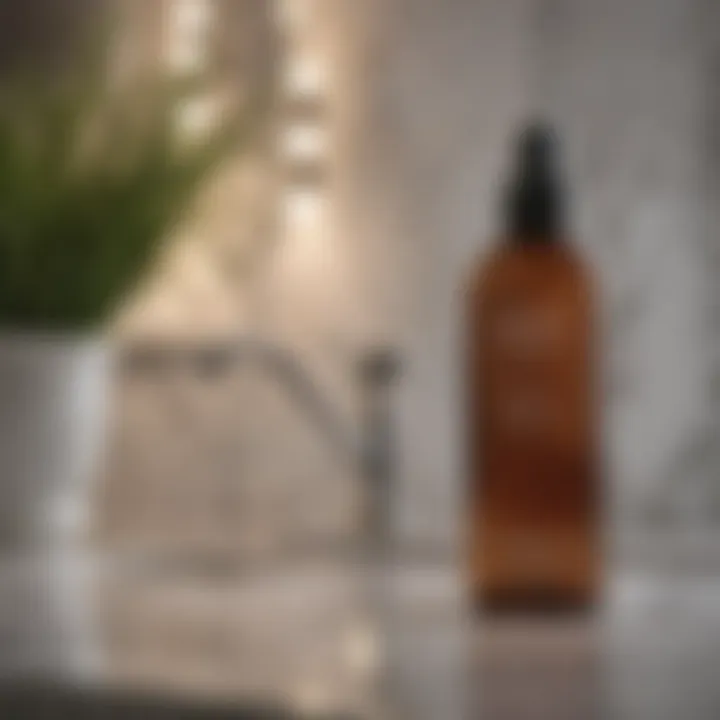Exploring the Best Tanning Mist: Insights and Recommendations


Intro
Tanning mists are gaining popularity for their convenience and effectiveness in achieving a sun-kissed look without the harmful effects of UV exposure. They offer an appealing alternative to traditional tanning methods, allowing users to maintain a natural glow while prioritizing skin health. As awareness about health and beauty evolves, more women are seeking products that fit into their lifestyles, align with ethical standards, and yield desirable results.
This article aims to explore the realms of tanning mists by examining their benefits and application techniques. It will focus on the essential criteria for selecting the best products, while also highlighting user experiences and ingredient analyses. Readers will be informed about safety practices and cultural contexts that surround beauty choices today. In an era where beauty is interlinked with sustainability, the discussion of tanning mists becomes particularly relevant.
Understanding Tanning Mists
Understanding tanning mists is crucial for anyone interested in achieving a sun-kissed glow without spending excessive time in direct sunlight. This section of the article will offer insights into the definition and purpose of tanning mists, as well as how they function. Tanning mists can provide a more controlled application compared to traditional tanning methods, making them popular among many users.
Definition and Purpose
Tanning mists, often referred to as self-tanning sprays, are formulated products designed to give the skin a bronzed appearance without the need for sun exposure. The primary purpose of these mists is to simulate a tan after just a few simple applications. They typically contain dihydroxyacetone (DHA), a colorless sugar that reacts with the amino acids in the outer layer of the skin, leading to a temporary browning effect. This effect lasts several days before fading, depending on skin type and care.
Moreover, tanning mists can be used on various skin types and can be adjusted for desired intensity. Unlike tanning beds or natural tanning, which can lead to skin damage over time, tanning mists offer a safer alternative, given that they do not involve harmful UV rays.
How Tanning Mists Work
The mechanics of how tanning mists work revolve primarily around the ingredient DHA. When applied to the skin, DHA interacts with the dead skin cells, causing a chemical reaction that results in a darkened appearance.
The application process is quite straightforward:
- First, the skin should be clean and exfoliated.
- Next, the user sprays the mist evenly across the desired areas while keeping a safe distance from the skin to ensure even coverage.
- Finally, the product dries quickly, allowing for subsequent applications if a deeper tan is desired.
In addition to DHA, some tanning mists include a mix of natural oils and botanical extracts that nourish the skin while providing a tan. This inclusion helps to avoid the dry or patchy look that can sometimes occur with lesser quality products.
"Tanning mists provide an effective solution for a radiant glow, enabling individuals to maintain a tan without the adverse effects of sun exposure."
In summary, understanding tanning mists involves recognizing their purpose as a safe alternative to traditional tanning methods. It highlights the science behind their operation and underscores their benefits, catering to diverse users seeking that coveted bronze look.
Different Types of Tanning Products
Understanding the variety of tanning products available is crucial for making informed decisions. This section explores the differences between these products, focusing specifically on tanning lotions, mists, self-tanners, and bronzers. Each type offers unique benefits and considerations that can influence a user’s tanning experience.
Tanning Lotions vs. Mists
Tanning lotions and mists are two popular choices for achieving a bronzed look. Each has distinct properties that cater to different preferences and skin types.
Tanning Lotions tend to be thicker in consistency. They often provide deeper hydration along with a sun-kissed glow. Users may find that lotion formulas allow for more control during application. It can also be easier to cover specific areas, preventing uneven tan or streaks. Many lotions also include ingredients that help moisturize the skin, which can improve the tanning experience.
Mists, on the other hand, offer a lighter coverage. They are generally easier and quicker to apply, making them suitable for on-the-go touch-ups. The aerosol formula usually delivers an even spray, minimizing the risk of streaks. Mists may dry faster than lotions, which could be an advantage for those who dislike waiting long periods before getting dressed.
Both products typically contain DHA, the active component that provides color to the skin. However, the user experience can vary significantly based on skin type and personal preference, so it is essential to consider which format aligns best with one's routine and lifestyle.
Self-Tanners and Bronzers
The distinction between self-tanners and bronzers is vital for understanding how to achieve the desired look.
Self-tanners penetrate the skin and react with amino acids, resulting in a lasting tan that may last several days. As they are available in various formulations like sprays, gels, and creams, users can select the option that best fits their absorption rate and desired intensity. Since self-tanners can create a more permanent color, it’s essential to apply them with precision for the best results.
Bronzers, conversely, provide immediate color. These products are often makeup-based and can be washed off at the end of the day. Bronzers serve as a simple solution for last-minute occasions. They can add radiance to the skin while also enhancing contours and giving an instant glow.


"Choosing between self-tanners and bronzers depends on whether you seek longevity in your tan or a temporary, flexible option."
The choice between these products ultimately comes down to personal needs and preferences. It’s essential to evaluate factors, including duration, intensity, and the desired look when selecting the right tanning product.
Key Ingredients in Tanning Mists
Understanding the key ingredients in tanning mists is crucial for making informed choices. These ingredients determine the effectiveness, safety, and overall quality of the product. Choosing the right tanning mist can enhance the look of your skin while ensuring a safer experience. In this section, we will explore the primary ingredients that contribute to the performance of tanning mists.
DHA: The Active Component
Dihydroxyacetone, commonly referred to as DHA, is the primary ingredient in most tanning mists. This compound interacts with the amino acids in the outer layer of the skin, triggering a reaction that results in a browning effect. The reaction is quite rapid, often producing a noticeable tan within a few hours after application.
DHA is derived from natural sources, making it a popular choice among consumers looking for safer alternatives to sun exposure or tanning beds. However, it is important to note that the quality and concentration of DHA can vary among products. A higher concentration usually yields a more intense tan, but it may also lead to an uneven appearance if not applied carefully. Therefore, beginners may benefit from starting with a lower concentration and gradually increasing as they become more familiar with the application process.
Natural Oils and Extracts
In addition to DHA, numerous natural oils and extracts are often incorporated into tanning mists. These ingredients serve various functions, from moisturizing the skin to enhancing the overall finish of the tan. Common natural oils include coconut oil, argan oil, and jojoba oil. They help to nourish the skin, providing hydration and preventing the dry, flaky appearance that can occur with some tanning products.
Moreover, extracts from fruits like aloe vera and green tea can provide antioxidants, further protecting the skin. These components work synergistically with DHA, contributing to a smoother application and more even results.
In choosing a tanning mist, consider products with a blend of these beneficial oils and extracts. They not only enhance the tanning experience but also promote better skin health overall.
Preservatives and Fragrances
Preservatives and fragrances are often included in tanning mists to maintain product integrity and improve user experience. While they can play a beneficial role, it is important to understand their implications.
Preservatives such as phenoxyethanol or ethylhexylglycerin help to prevent bacterial growth, extending the shelf life of the product. This is especially important for products that are applied directly to the skin. However, some individuals may experience sensitivities to certain preservatives, so it is wise to check ingredient labels if you have a history of skin reactions.
Fragrances, while enhancing the application experience, can also be a source of irritation for sensitive skin types. Opting for fragrance-free products may be a better choice for those with allergies or other sensitivities.
Remember: Always perform a patch test before applying any new tanning mist to prevent adverse reactions.
By being aware of and understanding the role of key ingredients, consumers can select tanning mists that align with their skincare needs and personal preferences. This informed approach will contribute to a safe and enjoyable tanning experience.
Evaluating the Best Tanning Mists
Evaluating the best tanning mists is a crucial step for anyone looking to achieve a natural and sun-kissed glow. This section will guide readers in making informed choices based on various factors that differentiate products in a crowded market. Understanding what to look for can enhance the tanning experience, minimize risks, and improve results.
Criteria for Selection
When selecting the best tanning mists, consumers should consider several important criteria:
- Skin Type Compatibility: Different mists suit dry, oily, or combination skin. Knowing one's skin type helps in choosing the right product to avoid adverse reactions.
- Color Outcome: Tanning mists vary in the shade they produce. Some users may prefer a subtle glow while others seek a deeper tan. It’s crucial to assess the final color on skin after application.
- Ingredients Quality: A thorough examination of the component list is essential. Ingredients like DHA are effective, while natural extracts like aloe vera can provide added benefits.
- User Ratings and Reviews: Feedback from other users provides insight about a product’s reliability. This also guides potential buyers in knowing what to expect.
- Price Point: Budget considerations are crucial too. Finding effective products within a reasonable price range ensures accessibility for more users.
Top Recommendations
The market features several tanning mists that stand out. Here are some top recommendations:
Product A Summary
Product A is highly regarded for its fast-drying formula. One aspect that makes it favorable is its blend of hydrating ingredients which help maintain skin moisture. Users often highlight its natural-looking tan and ease of application. The unique feature of Product A is its adjustable color intensity, allowing users to build their tan gradually. Nevertheless, some have noted a slightly stronger scent compared to other products, which may not be appealing to everyone.


Product B Summary
Product B is celebrated for its eco-friendly ingredients. It contains organic components that appeal to health-conscious consumers. The main characteristic of Product B is its lightweight feel upon application, leaving no sticky residue. This practice enhances comfort and usability. However, a few users mention that the color development takes longer, which may require patience during the waiting period.
Product Summary
Product C is known for its versatility; it can be used on both the face and body. Its rich consistency provides a deeper color that many users appreciate. A defining aspect of Product C is its quick absorbing formula. Users can both see and feel results within a short period. On the downside, this product may require a more precise application technique to avoid streaks, which makes practice essential.
Understanding different products and their features empowers users to make informed choices, ensuring satisfaction with their tanning experience.
Application Techniques
Understanding the proper application techniques for tanning mists is critical for achieving a natural-looking tan. Effective application not only maximizes results but also minimizes issues such as uneven tones or streaks. This section focuses on the necessary steps and considerations.
Preparation Steps
Before applying tanning mist, preparation is essential. Start with a clean and exfoliated skin to ensure an even result. You should use an exfoliating scrub or a gentle body wash to remove dead skin cells. Pay special attention to areas often neglected, like elbows and knees, as these can become darker if not prepped properly.
Additionally, moisturize the areas around your joints and any dry patches to create a barrier that helps prevent excess absorption. This means that the tan will come out smoother and more uniform.
How to Apply Tanning Mist
Applying tanning mist can require some practice. Firstly, hold the bottle around six to eight inches away from the skin. Move the mist in circular motions to avoid streaks. It is wise to start from the bottom and move upwards. This method ensures a more consistent application. Make sure to cover all areas evenly, including less visible regions like the back of the arms and legs.
To avoid any run-off or pooling, it's advisable to spray in sections. For example, apply product to one leg, then the other, ensuring you blend well. Be careful with your hands, as they may become darker than the rest of your body. Consider wearing gloves or using a tanning mitt for better control and to protect your palms.
Post-Application Care
After the application, you must follow some post-care steps. Allow the tanning mist to dry completely before getting dressed. This minimizes transfer and is crucial for optimal results. Not to mention, it avoids tan smudging onto clothing.
Moreover, it can be beneficial to avoid water or sweat for at least 6 to 8 hours after the mist has been applied. This resting period allows the DHA to develop fully for a deeper, more lasting color. Additionally, moisturizing regularly after application can prolong the tan and maintain its appearance.
Remember that proper application techniques make a significant difference in the outcome of your tanning mist experience. Follow these steps carefully for best results.
Skin Safety and Health Considerations
Understanding the safety and health aspects of using tanning mists is critical for ensuring a positive experience. Tanning products, while offering the allure of a sun-kissed glow, can pose risks if not carefully selected and applied. This section examines important elements that influence skin safety and health, such as skin types and potential allergic reactions.
Understanding Skin Types
Skin types vary widely among individuals. Knowing your skin type is essential before choosing a tanning mist. There are primarily four categories:
- Normal skin: This skin type has a balanced moisture level and is not prone to excessive dryness or oiliness.
- Dry skin: Characterized by flakiness and rough texture, individuals with dry skin should be cautious, as some tanning mists may exacerbate these issues.
- Oily skin: This type produces excess sebum, which can affect how tanning products are absorbed, possibly leading to an uneven tan.
- Combination skin: Featuring traits of both dry and oily skin, those with combination skin should select mists carefully to avoid pigmentation issues.
Choosing a tanning mist that complements your skin type is pivotal. Those with oily skin might prefer water-based mists, while individuals with dry skin may lean towards products enriched with hydrating ingredients.
Allergic Reactions and Sensitivities
When it comes to beauty products, no one is immune to allergic reactions. Tanning mists contain various chemicals and fragrances that can trigger sensitivities in some users. Common symptoms of an allergic reaction include redness, itching, and swelling. Here are important considerations regarding allergic reactions:
- Patch Test: Before applying a new tanning mist, perform a patch test on a small area of skin. This test should reveal any immediate reactions. Wait 24 hours to evaluate if any irritation occurs.
- Ingredient Research: Familiarize yourself with ingredients listed on product labels. Focus on avoiding DHA, parabens, and synthetic fragrances if you have known sensitivities.
- Dummy Products: Opt for brands that offer hypoallergenic or sensitive formulas. These options are formulated without common irritants, making them safer for sensitive skin.


Products today often come with detailed ingredient breakdowns. If sensitivity is a concern, it is wise to consult with a dermatologist.
"Skin safety should always be a priority. If you experience discomfort, discontinue use immediately and consider consulting a professional."
In summary, awareness of your skin type and vigilance about potential allergens can significantly influence the safety and enjoyment of using tanning mists. An informed choice will maximize benefits while minimizing risks.
Cultural and Social Perspectives on Tanning
The cultural and social perspectives on tanning have evolved considerably over time. These changes are deeply intertwined with notions of beauty, health, and lifestyle. Understanding these perspectives provides insights into why many women choose tanning mists as a part of their beauty routine. Today, tanning is often equated with a healthy glow and attractiveness, yet the underlying factors go beyond mere aesthetics.
Historical Context of Tanning
Historically, tanning has undergone significant transformation in its cultural perception. In ancient Egypt, for example, sun-kissed skin was a sign of wealth and leisure, while fair skin signified the labor of the working class. Fast forward to the mid-20th century, when Coco Chanel popularized the tanned look after accidentally getting sunburned during a yacht trip. This event sparked a trend that shifted societal views on tanning. In the following decades, bronzed skin became synonymous with glamour and beauty, particularly in Western culture.
However, as awareness of the health risks associated with excessive sun exposure grew, particularly regarding skin cancer, attitudes began to shift again. Tanning mists emerged as safer alternatives to traditional sunbathing, allowing individuals to attain a tanned appearance without the harmful effects of UV rays.
Current Trends and Attitudes
Today’s beauty standards reflect a diverse and inclusive view of tanning. Tanning mists are widely accepted as tools for achieving a natural-looking tan without the health risks of sun exposure. Social media platforms, such as Instagram and TikTok, significantly influence these trends, with influencers showcasing their glowing, tanned skin through various tanning products.
The current attitude towards tanning also emphasizes individual choice and body positivity. Many women embrace tanning as a way to enhance their self-image and feel confident. Additionally, the emergence of vegan and cruelty-free tanning products reflects a growing concern for ethical and sustainable practices. Consumers now consider ingredients and how products are made, not just the final aesthetic result.
"Cultural perspectives shape our understanding and acceptance of beauty practices, illustrating how trends evolve and gain meaning over time."
Sustainable Practices in Tanning Products
The discussion around sustainable practices in tanning products is becoming increasingly relevant. As consumers become more aware of the environmental impact of their choices, brands are shifting to reduce their carbon footprint. This is especially crucial in the beauty industry, where conventional tanning products often contain harmful chemicals that can impact both health and the environment.
One aspect to consider is how tanning mists can contribute to sustainability. Many companies are now focusing on eco-friendly formulas that use natural ingredients. This not only minimizes negative effects on the skin, but also on the planet. These products are often free of synthetic fragrances, parabens, and sulfates, which can be harmful. Instead, they incorporate plant-based ingredients that are less likely to cause irritation or allergic reactions, appealing to a broader audience.
"Choosing eco-friendly tanning products is not just about beauty; it's about health and sustainability for future generations."
Furthermore, the benefits extend beyond the products themselves. Sustainable practices in tanning also encompass sourcing raw materials responsibly. Ethical sourcing helps to ensure that the ingredients used in tanning mists come from renewable resources, benefiting the ecosystem. This fosters a cycle of sustainability, encouraging more companies to adopt responsible practices in their production methods.
Eco-Friendly Ingredients
When looking for eco-friendly tanning mists, it’s essential to understand what makes an ingredient truly sustainable. Common eco-friendly ingredients include:
- DHA (Dihydroxyacetone): Derived from natural sources like sugar beets or sugar cane, DHA is the key ingredient for self-tanners. It’s a safe alternative to traditional tanning methods and is biodegradable.
- Natural Oils: Ingredients such as coconut oil and argan oil not only hydrate the skin but also provide a natural sheen. These oils benefit from sustainable sourcing practices and often have a lower environmental impact.
- Plant Extracts: Various botanical extracts can enhance the tanning effect while nourishing the skin. Extracts from chamomile or green tea offer antioxidant properties, making them an excellent choice for mindful consumers.
Using these ingredients reduces not only the user's exposure to harmful compounds but also the environmental impact usually linked with traditional tanning products.
Packaging Innovations
The packaging of tanning products is another important factor in sustainability. Many brands are adopting innovative designs to minimize waste and improve recyclability. Some key trends include:
- Biodegradable Materials: More companies are shifting towards biodegradable packaging. This helps to ensure that product containers do not contribute to landfill waste.
- Refillable Options: Allowing consumers to refill their tanning mists reduces packaging waste significantly. This model encourages repeated use and supports a more sustainable consumption pattern.
- Minimalist Designs: By reducing excess packaging and focusing on essential elements, brands can cut down on material usage. This not only lowers costs but also aligns with consumer preference for minimalist aesthetics in beauty products.
Closure and Final Thoughts
The discussion about tanning mists has revealed much about their place in modern beauty routines. Tanning mists have gained popularity due to their ease of application and ability to impart a natural glow without the risks associated with sun exposure. This article underscored the significant considerations that individuals should keep in mind while selecting a tanning mist, such as skin type, ingredient safety, and desired results.
Recap of Key Points
- Understanding Tanning Mists: These products are specifically designed to provide a tanned appearance while minimizing the potential for skin damage. Tanning mists differ from traditional tanning methods, offering convenience and faster application.
- Types of Tanning Products: We discussed the distinctions between tanning lotions and mists, noting how each serves different preferences and needs.
- Key Ingredients: Consideration of active ingredients like DHA, along with natural oils, can affect the quality and safety of tanning mists. Preservatives are also important to note for sensitive skin.
- Evaluating Products: Criteria for selecting the best tanning mists were highlighted, alongside examples of top products that exemplify quality and effectiveness.
- Application Techniques: Proper methods for applying tanning mists can enhance results and ensure a more even tan. Preparation and post-application care are equally critical.
- Skin Safety: Awareness of individual skin types and possible allergic reactions ensures safer tanning experiences.
- Cultural Perspectives: The social context of tanning has evolved, reflecting diverse attitudes and historical significance regarding skin appearance.
- Sustainability Practices: Eco-friendly ingredients and sustainable packaging practices were discussed, aligning with consumers’ increasing prioritization of environmentally responsible products.
Making Informed Choices
Choosing a tanning mist should align with personal values as well as beauty goals. By embracing this knowledge, users can achieve a healthy, radiant glow while also respecting their skin’s integrity and the environment. Making choices informed by both product efficacy and ethical considerations fosters a more mindful approach to beauty.



